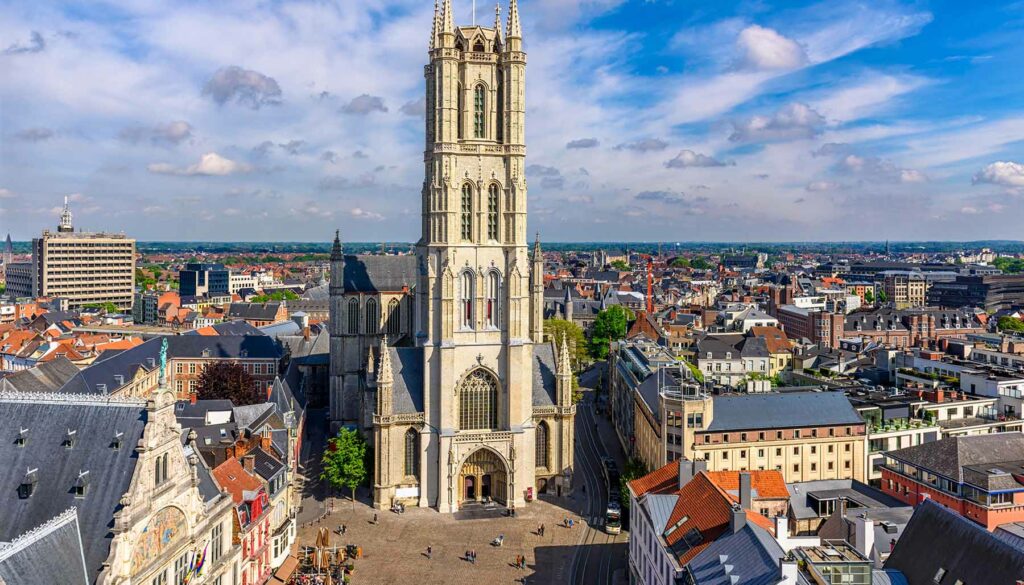There’s something fascinating about the world of art theft. Once an artist completes a work and releases it to the world, it’s part of the human race’s shared culture. As such, when a selfish thief takes it upon themself to steal a work of art and hide it away from the eyes of the public, it leaves a void for everyone who ever wanted to see the piece.
In other ways, art theft can be seen as a “softer” crime than other criminal endeavors, like armed robbery and murder. After all, if an art thief doesn’t hurt anyone and just makes off with an incredible painting, then it’s hard to say they’ve done much harm, right? Maybe this is why so many people are so enamored with tales of high-stakes art heists, picturing gentleman thieves swiftly pilfering paintings from gilded galleries.
One of the most often-stolen pieces of art in human history is the Ghent Altarpiece. Dutch artist Hubert van Eyck and his brother, Jan van Eyck, created this massive, multi-paneled work of art in the fifteenth century. The piece is impressive for both its size and its complex painted panels and has been the subject of numerous thefts and controversies over the centuries.
Commissioning the Work
The Ghent Altarpiece, also known as the Adoration of the Mystic Lamb, is a massive work of art commissioned by Jodocus Vijd, the mayor of Ghent in the 1420s. Vijd planned a massive renovation of the Saint Bavo Cathedral, and the altarpiece was intended to be an enormous centerpiece of the project.
Hubert van Eyck likely handled the design and construction of the piece by himself throughout the 1420s and then tapped his brother, Jan, for help with painting the panels. Art historians have debated whether it’s possible to tell any of the panels apart and ascribe their technique to either brother, though. As far as most experts can tell, it’s impossible to definitively say which panel was painted by which brother.
Notably, Jan seems to have understated his role in completing the piece. Hubert passed away in 1426, six years before Jan completed the project. The finished piece is massive, comprising twelve interior panels and sporting paintings along the back to allow it to present another mood while closed. It’s remarkably detailed, extremely complex, and regarded as one of the finest works of art of European art.
The Adoration of the Mystic Lamb
In short, the piece depicts several heavenly scenes. The exterior view is solemn and quiet, with muted colors and images of angels, saints, and worshipers. The interior view, meanwhile, is highly colorful and vibrant, depicting figures like the Virgin Mary, John the Baptist, and the titular Lamb of God. The piece is widely regarded as one of the first significant oil paintings and represents a shift from the art of the Middle Ages to the more complicated styles of the Renaissance.
The altarpiece was originally surrounded by a similarly-complicated outer frame. Some historians believe this frame likely connected all the panels’ outer frame paintings with an involved backdrop. The frame may have even housed clockwork mechanisms useful for opening and closing the altarpiece, allowing it to be swiftly reconfigured for feast days and other celebrations.
Sadly, the original frame was destroyed during the reformation, so this information is lost to history. However, this was hardly the final act of vandalism that would fall upon the work, as it would go on to become one of the most coveted and often-stolen pieces of art in human history.
War, Theft, and Restoration

The piece was damaged by time throughout the 1400s, and initial efforts to restore it were completed in 1550. Later in the 16th Century, a panel that depicted either Hell or Limbo was, ironically, destroyed in a fire. Church officials made efforts to protect the piece throughout the 1600s during the Protestant Reformation, briefly hiding it in the cathedral’s attic.
After the French Revolution, Napoleon’s armies stole the piece from Belgium and displayed it in the Louvre for a little over a decade. After Napoleon’s defeat at Waterloo, officials reclaimed the altarpiece and returned it to its original home in Ghent. This started a pattern of European leaders coveting the painting and making efforts to steal it from Brussels during wartime.
During the first World War, German soldiers stole some of the panels from the cathedral. The diocese had pawned off several of the panels in the 19th Century, but the German military carried all they could back with them after the war. One provision of the Treaty of Versailles, which ended the war, was that Germany’s government would return the Ghent Altarpiece panels – including pieces that had been legally purchased in the 1800s.
World War II
The German people were highly frustrated by the return of the altarpiece, especially since some of the panels had been acquired legally. During the Second World War, Adolf Hitler made the theft of the altarpiece a significant focus for his invading armies. Much has been written about Nazi art theft, but the Ghent Altarpiece was to be a jewel in the Third Reich’s collection.
After the start of the war in 1940, Belgian officials stored the painting in a museum in Pau so it wouldn’t be damaged by the fighting. However, after Italy sided with the Axis Powers and Germany seized control of France, the painting was moved to the Schloss Neuschwanstein in Bavaria. As the fighting intensified after the Allied counter-invasion of Europe, the German military moved it to a salt mine in Altaussee.
When Allied forces finally recovered the piece from the salt mines, they discovered it had been badly damaged by being stored so close to a large salt concentration. The remaining panels were brought back to Ghent, and another round of restoration was initiated in 1950. The restorers were able to use new technology like X-ray machines to peel back several layers of paint added by previous generations to “repair” the work.
The Just Judges

One of the panels still missing from the completed altarpiece is the Just Judges panel. This piece was stolen in 1934, along with the Saint John the Baptist portion of the work. The thief was never caught but did return the Saint John part of the work later as a token of “goodwill.” However, the Just Judges would remain a missing piece of art for decades. Its location is still a mystery.
The Just Judges panel is one of the most famous pieces of stolen art in European history. It’s often referenced in popular culture and appears in movies as an example of a notorious stolen work. In the Albert Camus novel The Fall, the protagonist Clamence keeps the long-missing painting in his apartment and considers himself a “judge-penitent.”
Camus imagines the painting having briefly hung from the wall of a bar in Amsterdam before Clamence convinced the bartender it was stolen and stashed it away in his apartment. Clamence convinces himself that he’s not doing anything wrong by keeping the painting because the judges share his demeanor, and there is no “innocent lamb of god” for them to meet anymore.
The Ransom
When the Just Judges was stolen in the 1930s, the Bishop of Ghent received a ransom note. The thief called for one million francs in exchange for the iconic work of art and even gave back the John the Baptist panel to convince the authorities that he would return the other piece in exchange for the ransom.
The bishop refused to cooperate with the thief, though, leaving the fate of the piece up to interpretation. Strangely enough, this element of the crime might have been partially solved later in 1935 when a Belgian broker named Arsène Goedertier told his family that he knew what happened to the painting. Just before his death, he claimed he was the only person who knew how to find the Just Judges.
However, Goedertier died before telling anyone where he supposedly stashed the panel. His family later found a note in his belongings that claimed the panel “can not be taken away without arousing the attention of the public.” If Goedertier really knew where the panel was hidden, he may have been the last person who could have recovered it.
Modern Day

Thankfully, the Just Judges was photographed before being stolen. A restorer named Jef Van der Veken created an impressive recreation of the panel in the 1950s to replace the stolen work, completing the iconic silhouette of the altarpiece. Still, authorities continue to pursue the long-missing painting.
Curious fans of art history can visit the painting in its original surroundings at the Saint Bavo Cathedral in Ghent, Belgium. It’s been on a long, strange journey and finally resides back where it was constructed to sit. It’s a testament to the tireless work of two 15th Century artists, numerous restorers, and countless preservation efforts that the altarpiece still exists.












